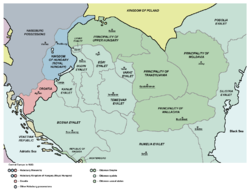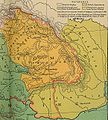- Principality of Transylvania (1570–1711)
-
Principality of Transylvania ← 
1570–1711  →
→

Flag Coat of arms Capital Gyulafehérvár(Alba-Iulia) 1570-1692
Hermannstadt(Sibiu)1692-1711Language(s) Latin (in administration, science and politics);
Hungarian, German, Romanian, Ruthenian (vernacular).Religion Roman Catholicism, Calvinism, Lutheranism, Eastern Orthodoxy,
Greek Catholicism, Unitarianism, JudaismGovernment Principality, Elective monarchy
Vassal state of the Ottoman Empire (1570-1683)
Vassal state of the Habsburg Monarchy (1699-1711)Rulers of Transylvania - 1570-1571 John II Sigismund Zápolya (first) - 1704-1711 Francis II Rákóczi (last) History - Established 1570 - Treaty of Karlowitz 1699 - Disestablished 1711 The Principality of Transylvania was a semi-independent state, ruled primarily by Hungarian princes.[1][2][3][4][5][6] As a semi-independent state, the Principality existed from 1570 to 1711. Until the Turkish defeat in the Great Turkish War (1683-1697), it was under the suzerainty of the Ottoman Empire. After the Treaty of Karlowitz (1699), it was a vassal state of the Habsburg Monarchy.
History of Hungary 
This article is part of a seriesPrehistory Prehistoric Pannonia Prehistoric Magyars Early history Roman Pannonia Magyar invasion Middle Ages (896–1541) Principality of Hungary
(896–1000)Medieval Kingdom of Hungary
(1000–1538)Turkish wars
(1366–1526)Early Modern history Habsburg Kingdom of Hungary
(1538–1867)Eastern Hungarian Kingdom
(1538–1570)Ottoman Hungary
(1541–1699)Principality of Transylvania
(1570–1711)Late modern period Rákóczi's War
(1703–1711)Revolution of 1848 Austria-Hungary
(1867–1918)Lands of the Crown of Saint Stephen Hungary in World War I Interwar period
(1918–41)Kingdom of Hungary
(1920-1946)World War II Contemporary history
(1946 to present)Republic of Hungary
(1946–49)People's Republic
(1949–89)Revolution of 1956 Republic of Hungary
(since 1989)Topical Church history Military history Music history Jewish history Székely people
Hungary Portal
Contents
Eastern Hungarian Kingdom and Zápolya family
Main article: Eastern Hungarian KingdomThe Eastern Hungarian Kingdom around 1550
 The partition of medieval Kingdom of Hungary between the Ottoman and Habsburg empires lasted more than 150 years [7] after the Battle of Mohács in 1526
The partition of medieval Kingdom of Hungary between the Ottoman and Habsburg empires lasted more than 150 years [7] after the Battle of Mohács in 1526
On 29 August 1526, the army of Sultan Suleiman of the Ottoman Empire inflicted a decisive defeat on the Hungarian forces at Mohács. John Zápolya was en route to the battlefield with his sizable army but did not participate in the battle for unknown reasons. The youthful King Louis II of Hungary and Bohemia fell in battle, as did many of his soldiers. As Zápolya was elected king of Hungary, Ferdinand from the House of Habsburg also claimed the throne of Hungary. In the ensuing struggle John Zápolya received the support of Sultan Suleiman I, who after his death in 1540 occupied Buda and central Hungary in 1541 under the pretext of protecting Zápolya's son, John II. Hungary was now divided into three sections: the West and north Royal Hungary, Ottoman Hungary, and the Eastern Hungarian Kingdom under Ottoman suzerainty, which later became the Principality of Transylvania where Austrian and Turkish influences vied for supremacy for nearly two centuries. The Hungarian magnates of Transylvania resorted to policy of duplicity in order to preserve independence.
Transylvania was now beyond the reach of Catholic religious authority, allowing Lutheran and Calvinist preaching to flourish. In 1563, Giorgio Blandrata was appointed as court physician, and his radical religious ideas increasingly influenced both the young king John II and the Calvinist bishop Francis David,[8] eventually converting both to the Anti-Trinitarian (Unitarian) creed. In a formal public disputation, Francis David prevailed over the Calvinist Peter Melius; resulting in 1568 in the formal adoption of individual freedom of religious expression under the Edict of Turda (the first such legal guarantee of religious freedom in Christian Europe, however only for Lutherans, Calvinists, Unitarians and of course Catholics, with the Orthodox Christian confession being explicitly banned).
Principality of Transylvania
The Báthory family, which came to power on the death of John II in 1571, ruled Transylvania as princes under the Ottomans, and briefly under Habsburg suzerainty, until 1602. Their rise to power marked the beginning of the Principality of Transylvania as a semi-independent state.
The younger Stephen Báthory, the first powerful prince of independent Transylvania,[8] a Hungarian Catholic who later became King under the name Stephen Bathory of Poland,[8] undertook to maintain the religious liberty granted by the Edict of Turda, but interpreted this obligation in an increasingly restricted sense. The latter period of Báthory rule saw Transylvania under Sigismund Báthory -prince of the Holy Roman Empire-[8] enter the Long War, which started as a Christian alliance against the Turks and became a four-sided conflict involving Transylvania, the Habsburgs, the Ottomans, and the voivode of Wallachia, Michael the Brave. After 1601 the Principality for a short time was under the rule of Rudolf I who initiated the Germanization of the population, and in order to reclaim the Principality for Catholicism the Counter Reformation. From 1604-1606, the Hungarian nobleman Stephen Bocskay led a successful rebellion against Austrian rule. Bocskay was elected Prince of Transylvania on 5 April 1603 and prince of Hungary two months later. He achieved the Peace of Vienna in 1606.[8] By the Peace of Vienna, Bocskay obtained religious liberty and political autonomy, the restoration of all confiscated estates, the repeal of all "unrighteous" judgments, and a complete retroactive amnesty for all Hungarians in Royal Hungary, as well as his own recognition as independent sovereign prince of an enlarged Principality of Transylvania. By the Treaty of Vienna (1606) was guaranteed the right of Transylvanians to elect their own independent princes, but Georg Keglević, who was the Commander-in-chief, General, Vice-Ban of Croatia, Slavonia and Dalmatia, was since 1602 Baron in Transylvania. It was a very difficult and complicated peace treaty after a long war.
Under Bocskay's successors Transylvania had its golden age, especially under the reigns of Gábor Bethlen and George I Rákóczi. Gábor Bethlen, who reigned from 1613 to 1629, perpetually thwarted all efforts of the emperor to oppress or circumvent his subjects, and won reputation abroad by championing the Protestant cause. Three times he waged war on the emperor, twice he was proclaimed King of Hungary, and by the Peace of Nikolsburg (December 31, 1621) he obtained for the Protestants a confirmation of the Treaty of Vienna, and for himself seven additional counties in northern Hungary. Bethlen's successor, George I Rákóczi, was equally successful. His principal achievement was the Peace of Linz (September 16, 1645), the last political triumph of Hungarian Protestantism, in which the emperor was forced to confirm again the articles of the Peace of Vienna. Gabriel Bethlen and George I Rákóczi also did much for education and culture, and their era has justly been called the golden era of Transylvania. They lavished money on the embellishment of their capital Alba Iulia, which became the main bulwark of Protestantism in Eastern Europe. During their reign Transylvania was also one of the few European countries where Roman Catholics, Calvinists, Lutherans, and Unitarians lived in mutual tolerance, all of them belonging to the officially accepted religions - religiones recaepte, while the Orthodox, however, were only tolerated.
The fall of Nagyvárad (1660) marked the decline of the Principality of Transylvania with the Habsburg monarchs gaining increased control of this territory. Under Prince Kemeny, the diet of Transylvania proclaimed the secession of Transylvania from the Ottomans (April 1661) and appealed for help to Vienna but a secret Habsburg-Ottoman agreement resulted in further increasing Habsburg influence. After the defeat of the Ottomans at the Battle of Vienna in 1683, the Habsburgs gradually began to impose their rule on the formerly autonomous Transylvania. At the end of the 17th century, Transylvania was attached to the Habsburg controlled Hungary[9][10] and subjected to the direct rule of the emperor's governors. From 1711 onward, Habsburg control over Transylvania was consolidated, and the princes of Transylvania were replaced with governors.
See also
Gallery
References
- ^ Helmut David Baer (2006). The struggle of Hungarian Lutherans under communism. Texas A&M University Press. pp. 36–. ISBN 9781585444809. http://books.google.com/books?id=jr-dpNHlb2UC&pg=PA36. Retrieved 14 July 2011.
- ^ Eric Roman (2003). Austria-Hungary & the successor states: a reference guide from the Renaissance to the present. Infobase Publishing. pp. 574–. ISBN 9780816045372. http://books.google.com/books?id=EvCfTIsTOskC&pg=PA574. Retrieved 14 July 2011.
- ^ J. Atticus Ryan; Christopher A. Mullen (1998). Unrepresented Nations and Peoples Organization: yearbook. Martinus Nijhoff Publishers. pp. 85–. ISBN 9789041110220. http://books.google.com/books?id=yiesQNB3SAMC&pg=PA85. Retrieved 14 July 2011.
- ^ Iván Boldizsár (1987). NHQ; the new Hungarian quarterly. Lapkiadó Pub. House. p. 41. http://books.google.com/books?id=ACe3AAAAIAAJ. Retrieved 14 July 2011.
- ^ Marshall Cavendish (2009). "Greece and the Eastern Balkans,". World and Its Peoples: Europe. 11. Marshall Cavendish. p. 1476. ISBN 9780761479024. http://books.google.co.uk/books?id=b5vHRWp8yqEC&pg=PA1476&dq=Hungarian+princes+Transylvania&hl=en&ei=8EggTc3hAcaJhQfuho23Dg&sa=X&oi=book_result&ct=result&resnum=8&ved=0CEkQ6AEwBw#v=onepage&q=Hungarian%20princes%20&f=false. Retrieved 14 July 2011.
- ^ Paul Lendvai (2003). The Hungarians: a thousand years of victory in defeat. C. Hurst. pp. 106–. ISBN 9781850656739. http://books.google.com/books?id=UtIr97n3tP0C&pg=PA106. Retrieved 14 July 2011.
- ^ A Country Study: Hungary. Federal Research Division, Library of Congress. http://lcweb2.loc.gov/cgi-bin/query/r?frd/cstdy:@field(DOCID+hu0021). Retrieved 2009-01-11.
- ^ a b c d e Richard Bonney, D. J. B. Trim, David J. B. Trim, Persecution and pluralism: Calvinists and religious minorities in early modern Europe, 1550-1700, Peter Lang, 2006 [1]
- ^ Transylvania. (2011). In Encyclopædia Britannica. Retrieved from http://www.britannica.com/EBchecked/topic/603323/Transylvania
- ^ Transylvania; The Columbia Electronic Encyclopedia® Copyright © 2007, Columbia University Press. Licensed from Columbia University Press. All rights reserved. www.cc.columbia.edu/cu/cup/
 Subdivisions of the Ottoman Empire
Subdivisions of the Ottoman EmpireEyalets (1363–1864) AfricaAnatoliaAdana · Aidin · Anatolia · Ankara · Archipelago · Diyarbekir · Dulkadir · Erzurum · Hüdavendigâr · Karaman · Karasi · Kars · Kastamonu · Rum · Trebizond · VanAsiaEuropeVilayets (1864–1922) AnatoliaAdana · Aidin · Ankara · Archipelago · Bitlis · Diyâr-ı Bekr · Erzurum · Hüdavendigâr · Istanbul · Kastamonu · Konya · Mamuret-ul-Aziz · Sivas · Trebizond · VanEuropeElsewhereVassals and autonomies Cossack Hetmanate · Cretan State · Crimean Khanate · Khedivate of Egypt · Principality of Moldavia · Sharifate of Mecca · Republic of Ragusa · Eastern Rumelia · Principality of Samos · Serbian Despotate · Duchy of Syrmia · Principality of Transylvania · Tunis Eyalet · Principality of WallachiaSee also the list of short-lived Ottoman provincesCategories:- Former countries in Europe
- States and territories established in 1570
- States and territories disestablished in 1711
- 1711 disestablishments
- States and territories established in 1571
- History of Transylvania
- History of Hungary
- Former countries in Romania
- Vassal and tributary states of the Ottoman Empire
Wikimedia Foundation. 2010.




